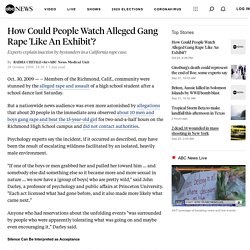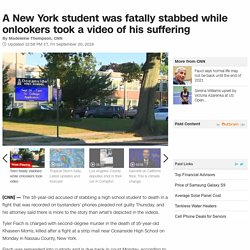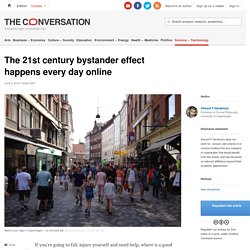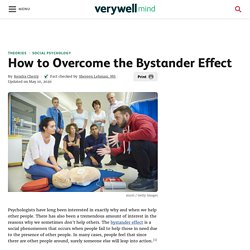

Contrary to common sense, individuals are more likely to take action if there are fewer or no other witnesses present in an emergency situation. This is also known as Bystander Apathy. (Video) The Bystander Effect. (Video) The Bystander Effect. (Video) Is the Bystander Effect Real? (Video) Are We Victims Of "Bystander Effect"?
(Video) The bystander effect is complicated. 37 Who Saw Murder Didn't Call the Police; Apathy at Stabbing of Queens Woman Shocks Inspector. The man explained that he had called the police after much celiberation.

He had phoned a friend in Nassau County for advice and then he had crossed the roof of the building to the apartment of the elderly woman to get her to make the call. “I didn't want to get involved,” he sheepishly told the police. Six days later, the police arrested Winston Moseley, a 29year‐old business-machine operator, and charged him with the homicide. Moseley had no previous record. He is married, has two children and owns a home at 133‐19 Sutter Avenue, south ozone Park, Queens. When questioned by the police, Moseley also said that he had slain Mrs. The police stressed how sim‐ple it would have been to have gotten in touch with them. The question of whether the witnesses can be held legally responsible in any way for failure to report the crime was put to the Police Department's legai bureau.
“There is no legal responsibil‐ity with few exceptions, for any citizen to report a crime.” How Could People Watch Alleged Gang Rape 'Like An Exhibit'? Oct. 30, 2009 — -- Members of the Richmond, Calif., community were stunned by the alleged rape and assault of a high school student after a school dance last Saturday.

But a nationwide news audience was even more astonished by allegations that about 20 people in the immediate area observed about 10 men and boys gang rape and beat the 15-year-old girl for two-and-a-half hours on the Richmond High School campus and did not contact authorities. Psychology experts say the incident, if it occurred as described, may have been the result of escalating wildness facilitated by an isolated, heavily male environment. "If one of the boys or men grabbed her and pulled her toward him ... and somebody else did something else so it became more and more sexual in nature ... we now have a [group of boys] who are pretty wild," said John Darley, a professor of psychology and public affairs at Princeton University. "Each act licensed what had gone before, and it also made more likely what came next. " The Death of Raymond Zack: No Heroes, Only Bystanders.
50-year-old Raymond Zack waded into the surf on an Alameda, California beach and stood calmly in the 54-degree water, apparently waiting to die.

His suicide took nearly an hour, but eventually he drowned, with no rescue attempts from any of the 75 San Franciscans who gathered on the shore to watch the entire tragedy. Why didn’t anyone try to rescue the man? Apparently it was because nobody was paid to do it. You see, stopping Zack from killing himself wasn’t anyone’s job. The media’s focus in reporting yet another disturbing incident with echoes of the murder of Kitty Genovese has been exclusively on the inert Alameda police and firemen who witnessed Zack’s suicide. What does the AP mean, “they could only watch”? City budget cuts caused the fire department to discontinue water rescue training and stop maintaining wetsuits and other rescue gear, a fire chief explained. Oh, they had to watch because they were handcuffed! The Golden Gate Rule: “It’s not my problem.” Apathy. A New York student was fatally stabbed while onlookers took a video of his suffering. Tyler Flach is charged with second-degree murder in the death of 16-year-old Khaseen Morris, killed after a fight at a strip mall near Oceanside High School on Monday in Nassau County, New York.

Flach was remanded into custody and is due back in court Monday, according to Brendan Brosh, a spokesman for the Nassau County District Attorney. Defense attorney Edward Sapone said Flach maintains his innocence. When the fight broke out Monday, a group of 50-70 teenagers looked on as Morris was assaulted and stabbed in the chest, according to Detective Lt.
Bystander inaction, like 7-Eleven assault, more likely with more witnesses, experts say - Chicago Tribune. 10 Notorious Cases of the Bystander Effect. The 21st century bystander effect happens every day online. If you’re going to fall, injure yourself and need help, where is a good place to do it?

Should you choose a busy thoroughfare or a deserted backstreet? Statistics and experiments in social psychology will tell you that if you need help, you should avoid dropping in a busy street, even if hundreds of people are passing through. This is because of a phenomenon known as the bystander effect. The more individuals gathered in one place, the less chance there is of one of them coming to the aid of a person in need. How the bystander effect can explain inaction towards global warming. Not too long ago, I was preparing a lecture about group dynamics for my students at Delft University of Technology.

How Diffusion of Responsibility Affects Group Behavior. Diffusion of responsibility is a psychological phenomenon in which people are less likely to take action when in the presence of a large group of people.1 For example, imagine that you are in a large city on a bustling street.

You notice a man fall to the ground and start convulsing as if having a seizure. Many people turn and look at the man, but no one moves to help or call for medical assistance. Why? Understanding Pluralistic Ignorance in Social Psychology - Psychologenie. How to Overcome the Bystander Effect.
Psychologists have long been interested in exactly why and when we help other people.

There has also been a tremendous amount of interest in the reasons why we sometimes don't help others. The bystander effect is a social phenomenon that occurs when people fail to help those in need due to the presence of other people. In many cases, people feel that since there are other people around, surely someone else will leap into action.1 While the bystander effect can have a negative impact on prosocial behavior, altruism and heroism, researchers have identified a number of different factors that can help people overcome this tendency and increase the likelihood that they will engage in helping behaviors.2 Some of these include: Witnessing Helping Behavior.
Participating in Bystander Intervention Programmes. The likelihood of a victim's survival will increase more than threefold with intervention.

PHOTO: ST FILE SINGAPORE - A study has found that three measures, when applied together, have more than doubled the likelihood of bystanders performing cardiopulmonary resuscitation (CPR) on cardiac arrest victims in Singapore. Dispatch-assisted CPR, CPR and automated external defibrillator training, and the Singapore Civil Defence Force's myResponder app were found to have increased the responses of bystanders giving life-saving assistance to heart attack victims before paramedics attended to them.
Dispatch-assisted CPR refers to CPR that is administered under the guidance of a first responder, such as a paramedic who may, through a phone call, assess the situation and give instructions to a bystander, who then performs CPR. The study was conducted by researchers at the Duke-NUS Medical School, Duke University, and several organisations here, and published in August. Everyone's Confused In Meetings But No One Asks Questions - Here's What Needs to Change. Picture this: You're in an important meeting with senior leadership.

The CEO is sharing the firm's strategic plan, including how the company will "leverage big data to gain visibility into market opportunities producing measurable ROI". Um...what? You do a quick scan around the conference room. Heads nod in agreement as the CEO concludes. Overcoming the Bystander Effect. Darley & Latané (1968) - Bystander Apathy. Darley & Latané (1968) - Bystander intervention in emergencies: diffusion of responsibility. Darley & Latané (1968) - Group inhibition of bystander intervention in emergencies. Clark & Word (1972) -Why don't bystanders help? Because of ambiguity? Chekroun & Brauer (2002) - The bystander effect and social control behavior: the effect of the presence of others on people’s reactions to norm violations. Garcia et. al. (2002) - Crowded Minds: The Implicit Bystander Effect.
Hudson & Bruckman (2004) - The Bystander Effect: A Lens for Understanding Patterns of Participation. Fischer et. al. (2011) - The bystander-effect: a meta-analytic review on bystander intervention in dangerous and non-dangerous emergencies.